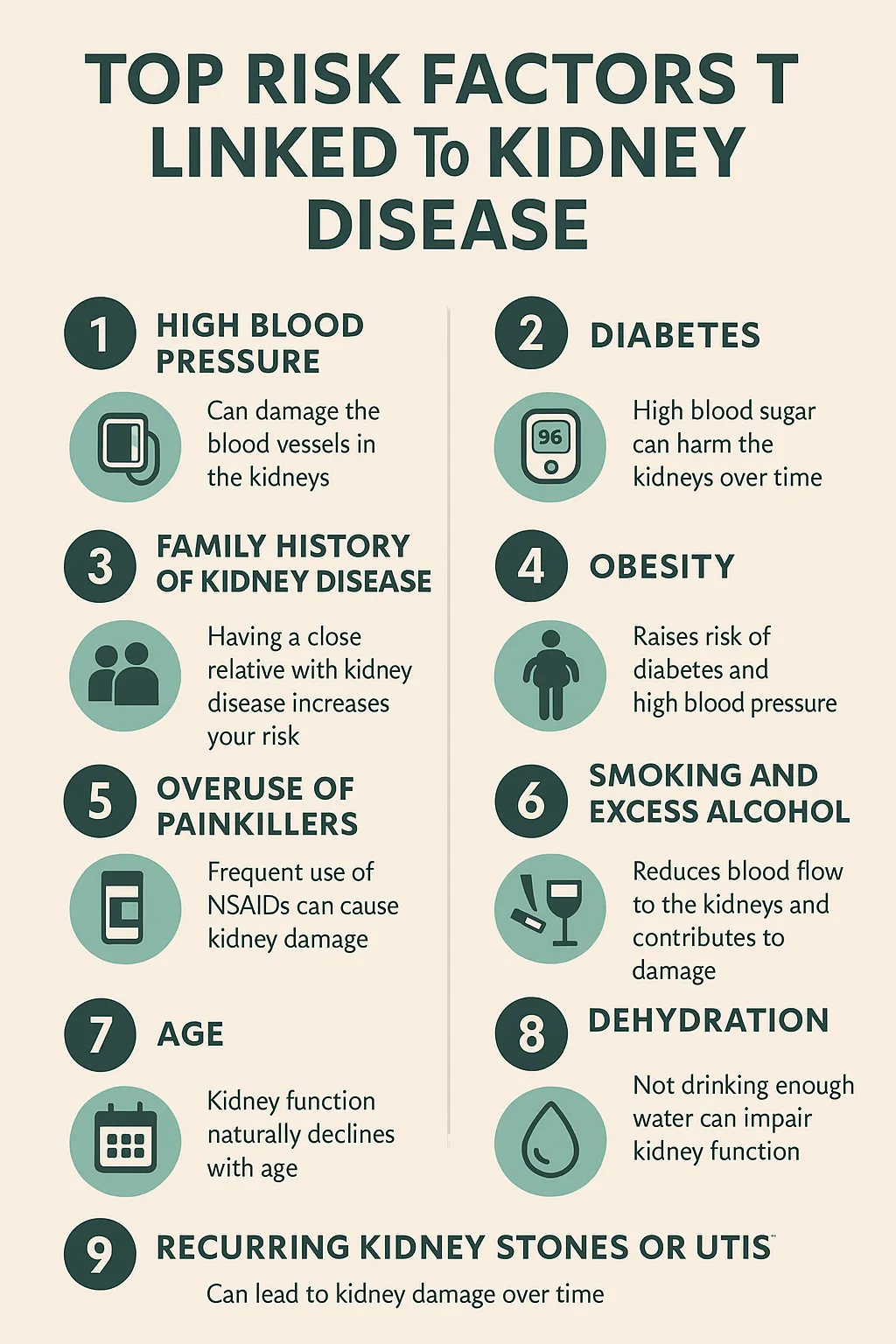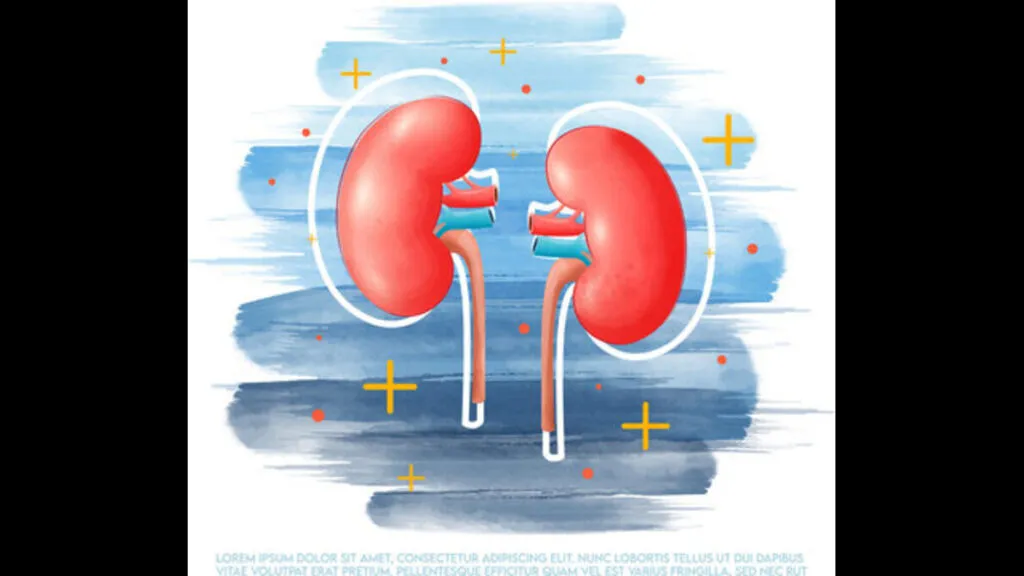Top Risk Factors Linked to Kidney Disease (And What You Can Do About Them)
Let’s be real for a second kidney disease often flies under the radar. It doesn’t always come with big flashing warning signs, and for many people, it develops quietly over time.
You might feel fine until, one day, your doctor mentions “elevated creatinine” or a “reduced GFR,” and suddenly you’re Googling kidney function at 2 a.m.
Sound familiar?
Well, you’re not alone. In my experience working with people managing kidney health whether newly diagnosed or years into their journey the biggest surprise for many is how preventable a lot of kidney damage can be. But prevention starts with awareness.
So, let’s talk about the top risk factors linked to kidney disease. Think of this as a friendly roadmap not to scare you, but to empower you. Because when you know what to look out for, you’re already one step ahead.

1. High Blood Pressure (The Silent Squeeze)
Ever heard of high blood pressure being called the “silent killer”? That’s not just dramatic phrasing—it’s spot on. Hypertension quietly damages the tiny blood vessels in your kidneys, making it harder for them to do their job.
👉 Real talk: We had a patient who thought “a little high” blood pressure wasn’t a big deal—until their lab work showed early-stage kidney disease. With just a few tweaks (less salt, more movement, and a daily walk), they turned their numbers around.
Moral of the story? Don’t ignore the silent stuff. Get your BP checked regularly and take those numbers seriously.
2. Diabetes (Especially Type 2)
If your blood sugar is out of control, your kidneys are the ones left cleaning up the mess. High glucose levels over time damage the kidneys’ filtering system, and that’s how diabetic kidney disease (nephropathy) sets in.
📊 According to the National Kidney Foundation, 1 in 3 adults with diabetes has chronic kidney disease.
So, ask yourself: When was the last time I had my A1C checked?
If you’re prediabetic or diabetic, tight glucose control and kidney-friendly nutrition can truly be game-changers.
3. A Family History of Kidney Disease
Have a parent, sibling, or grandparent who dealt with kidney problems? That’s more than a passing detail—it’s a genetic flag. While you can’t change your DNA, you can get ahead of the curve with early testing and lifestyle choices.
💡 Tip: Tell your doctor if kidney disease runs in your family. It can influence how often they check your labs—and when they intervene.
4. Obesity (More Than Just a Number)
This one’s tricky, and I say that with total compassion. Weight is complex—it’s emotional, personal, and not just about looks. But from a kidney perspective, extra weight can strain kidney function, increase your risk of high blood pressure and diabetes, and make inflammation worse.
Instead of obsessing over pounds, focus on small, sustainable habits: drink more water, eat more whole foods, move your body a little each day. You don’t need to be a size 2 to have healthy kidneys—you just need to support them consistently.
5. Overuse of Painkillers (Yes, Really)
We’ve seen this more times than I can count: someone dealing with chronic pain reaches for over-the-counter NSAIDs like ibuprofen every day, unaware that these meds can harm the kidneys over time.
💊 If you’re using painkillers regularly, talk to your doctor. There are safer alternatives—especially if your kidney health is already at risk.
6. Smoking and Excess Alcohol
It’s not just your lungs and liver taking the hit—smoking reduces blood flow to the kidneys, and too much alcohol can spike blood pressure and dehydrate the body.
I get it—it’s hard to quit. But if you’ve ever needed a reason bigger than yourself, protecting your kidneys is a powerful one.
7. Age (Not a Risk, But a Reminder)
Here’s the truth: kidney function naturally declines with age. It doesn’t mean disease, but it does mean we need to be more mindful as we get older.
📅 If you’re over 60, even without major health issues, ask your doctor to check your kidney function once a year. It’s quick, it’s easy, and it can catch changes early.
8. Dehydration (More Common Than You Think)
You’d be surprised how many people walk around mildly dehydrated every day—and how essential hydration is for flushing out waste. If you’re not drinking enough water, your kidneys are basically working with dry sponges.
💧 Aim for 2.5–3 liters a day. More if you sweat a lot or live somewhere hot.
9. Recurring Kidney Stones or UTIs
If you’ve had kidney stones or frequent urinary tract infections, it’s not just an inconvenience. Both can increase your risk of long-term kidney damage.
I’ve worked with patients who ignored recurrent UTIs, only to find out years later that scar tissue had impacted their kidneys. Don’t brush these off—treat them thoroughly and look into prevention strategies.
Final Thoughts: Are You Listening to Your Kidneys?
Kidneys don’t complain loudly. They don’t send you urgent texts or make dramatic exits. They just keep working… until they can’t. And by then, you may already be deep into the disease process.
That’s why awareness is everything. Knowing the risk factors—your blood pressure, your blood sugar, your family history—isn’t about fear. It’s about freedom. The freedom to take action, to ask smarter questions, and to protect your health before problems grow.
So, here’s your gentle nudge: What’s one thing you can do today to show your kidneys a little love?
Maybe it’s booking a checkup. Maybe it’s drinking more water. Or maybe it’s just sharing this info with someone you care about.
Whatever it is, your kidneys will thank you.
📚 Trusted Sources:
- National Kidney Foundation
- Centers for Disease Control and Prevention (CDC)
- Mayo Clinic – Chronic Kidney Disease
👩⚕️ About the Author:
Sophia M. is a clinical health writer, kidney health advocate, and content creator for MedLifeGuide.com. Her work blends expert insights with patient-centered guidance to help everyday people take charge of their wellness.
⚠️ Disclaimer:
This content is for informational purposes only and does not replace professional medical advice. Always consult your healthcare provider before making lifestyle changes or interpreting lab results.

